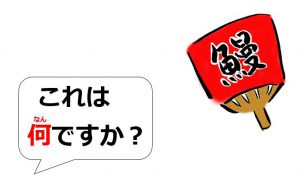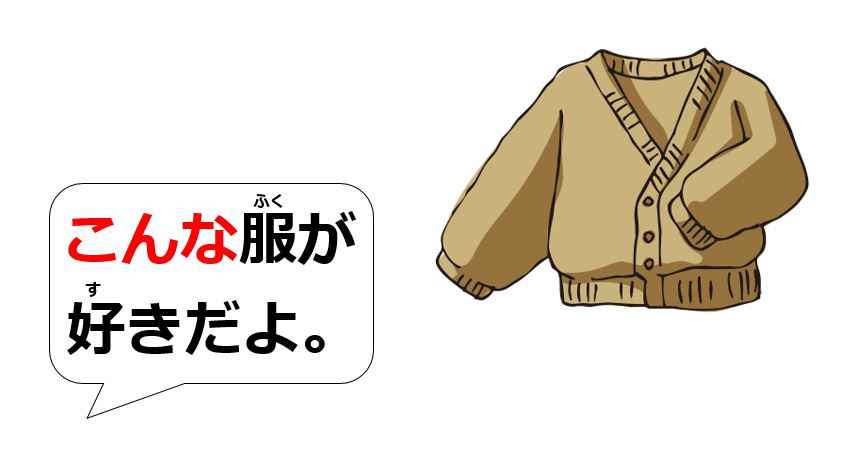Last time, you learned Japanese wh-questions with Japanese demonstratives which work as pronouns and determiners, like “どの服が着物ですか (which clothes are kimono)?” In this lesson, you will learn the rest of them with their related question words.
Japanese Wh-questions with Demonstratives: こそあど
| Table of Contents どんな: What Kind of… どう: How |
For review, we will show the whole table again. You will tackle attributes and proadverbs here. Be careful; there is an irregular pronunciation: ああ.
| こ– | そ– | あ– | ど– | ||
|---|---|---|---|---|---|
| Pronouns | れ-group thing |
これ this one |
それ that one |
あれ that one over there |
どれ which one |
| こ-group location |
ここ here |
そこ there |
あそこ* over there |
どこ where |
|
| っち-group ちら-group direction |
こっち こちら this way |
そっち そちら that way |
あっち あちら that way over there |
どっち どちら which way |
|
| いつ-group people |
こいつ this person |
そいつ that person |
あいつ that person over there |
どいつ which person |
|
| Determiners | の-group | この this… |
その that… |
あの that… over there |
どの which… |
| Attributes | んな-group kind |
こんな this kind of… |
そんな that kind of… |
あんな that other kind of… |
どんな what kind of… |
| Proadverbs | う-group kind |
こう like this |
そう like that |
ああ* like that over there |
どう how |
どんな (What kind of…) with んな-group
んな-group: Attribute
| こんな服はかわいい(です)よね。 This type of clothing is pretty, isn’t it? *Said while you’re pointing at a picture near you. |
| そんな人は(知らない / 知りません)。 As for that kind of person, [I] don’t know. *Said while you’re pointing at a picture near the listener. |
んな-group words work as attributes and are always placed before nouns like の-group: determiners. In the first example, if you say この服, it means that the clothes on the picture (*only one) are pretty. However, by using attributes: こんな, it means that clothes like the picture (*unlimited number) are pretty. That’s the difference.
| こ | そ | あ | ど |
| このような こういう こうした こういった |
そのような そういう そうした そういった |
あのような ああいう ああした ああいった |
どのような どういう – どういった |
んな-group sounds a little casual and is preferred in speaking. If you would like to use formal expressions, the above ones have the same meaning, but sound formal.
どんな: What Kind of…
| 着物は | どんな服 | (ですか)? |
| Topic / Subject | Complement | Question Marker |
| As for Kimono, what kind of clothing is [it]? | ||
どんな is the question word related to んな-group. Basically, this is used with generic nouns. With the example above, 着物 is a specific name of clothes. You need to use the generic noun: “clothing” in order to ask what kimono is like. With the last example below, the の (of どんなの) works as a noun and represents clothes. As you learned in the lesson for the particle の, when the context clearly tells what or whom you’re referring to, this kind of replacement happens.
| 東京はどんな街(ですか)? As for Tokyo, what kind of town is [it]? |
| 田中さんはどんな人(ですか)? As for Tanaka-san, what kind of person is [he/she]? |
| 着物はどんなの(なの / なんですか)? As for Kimono, what kind of [clothing] is [it]? |
The following examples are questions which directly ask about attributes of generic nouns while the previous ones ask about attributes of specific nouns.
| どんな人が成功(する / しますか)? What kind of people will succeed? |
| どんなご飯を食べる(の / んですか)? What kind of meals will [you] eat? |
| どんな場所で歌う(の / んですか)? At what kind of place will [you] sing? |
どう (How) with う-group
う-group
| こう走る(んだ / んです)よ。 [You] run like this. *Said while showing a model by yourself when you’re asked, “How should I run?” |
| ああする(んだ / んです)よ。 [You] do X like that over there. *Said while pointing to a model over there when you’re asked, “How should I do X?” |
う-group words work as proadverbs, and basically modify adjectives, verbs, and other adverbs. The nuance may look similar to んな-group (attributes) for English speakers. However, they are not interchangeable. In English, “like this” is a versatile phrase. For example, you can say:
A: Do you like music?
B: Yes. I especially like music like this. *when there is background music.
What do you think is suitable for this situation: こんな or こう? The answer is こんな because こう works as a proadverb and basically modifies adjectives, verbs, and other adverbs, while こんな expresses attributes of nouns. In this context, you’re talking about what kind of music you like (attributes). The translation “like this” may cause confusion, but try to think Japanese as it is.
A: 音楽は好きですか?
B: はい。特にこんな音楽が好きです。
Again, how about the following situation? Let’s think about which is suitable: こんな or こう.
A: This “Let It Be” sounds a little strange, doesn’t it? *when someone imitates Beatles.
B: People who sing [the song] like this are rare, aren’t they?
By contrast, you can use only こう here because you’re talking about how he/she sings. Verbs have to be modified by adverbs.
A: このLet It Beは少し変ですね。
B: こう歌う人は珍しいですね。
[adsense]
どう: How
| [それは] | どう | 違う(の / んですか)? |
| [Topic / Subject] | Proadverb | Verb |
| How does [that] differ? | ||
どう is the question word related to う-group. The basic concept comes from adverbs. Thus, if you have difficulty understanding どう, we recommend you review the previous lesson: Japanese adverbs. There are three main functions. The first is to seek a description and generally used for words which can have degree. When it comes to answers, specific ones are often preferred. For example, when you see a doctor, he/she often asks the second example below. You can reply like, “背中が鈍く痛い (I have a dull pain on my back).”
| どう美人(なの / なんですか)? How good-looking [woman] is [she]? |
| どう痛い(ですか)? How painful is [it]? |
The second is to ask about manner. This function generally appears with verbs. When it comes to how to answer, with the third example below, you can answer by using both a specific method like クロールで (by crawling) and adverbs of manner like ゆっくり (slowly).
| どう(歌う / 歌いますか)? How do [you] sing? |
| どう説明(する / しますか)? How do [you] explain? |
| どう(泳ぐ / 泳ぎますか)? How do [you] swim? |
The third is an exception. This function can be considered idiomatic and so you need to just memorize set phrases. The major ones are below. They don’t ask degree or manner, but objects of verbs.
| どう(思う / 思いますか)? What do [you] think? |
| どう(する / しますか)? What will [you] do? |
| どうなる(の / んですか)? What will [it] result in? |
You can even reword them with 何 (なに・なん).
| あなたの意見は(なに / なんですか)? What is your opinion? (*=What do you think?) |
| 何を(する / しますか)? What will [we] do? |
| 何が起きる(の / んですか)? What will happen? (*=What will [it] result in?) |
Respond to Questions with そう
| 私もそう(思う / 思います)。 I think so, too. *Said when someone says to you, “I think it will rain tomorrow.” |
そう is often utilized to respond to questions. Since this is the proadverb indicating a near space to someone whom you talk with, you can essentially use this to quote what someone said or did. With the above example, the “so” indicates “it will rain tomorrow.” Here are more examples.
| そう(だ / です)。 [It] is so. |
| そう(言う / 言います)よ。 [I will] say so. |
| そう(する / します)。 [I will] do so. |
そう has some set phrases. The typical example is そうですか or そうなんですか. This is generally used when responding to people. The か comes from the question marker and implies it’s the first time for you to hear it. The translation doesn’t work well, but you may regard it as “Really,” “Oh, is it,” I didn’t know that.”
| 知っている?来月にジブリが新しい映画を出すよ。 Do [you] know? Ghibli will release a new movie next month. |
| そうなんですか。楽しみですね。 Oh is it? [I’m] looking forward, aren’t I? |
Summary
- んな-group works as attributes and is always placed before nouns.
- う-group works as a proadverb and to modify adjectives, verbs, and other adverbs.
- そう is a proadverb, but works essentially to quote what someone said or did.
You have completed Japanese demonstratives and almost all the question words. The amount of the explanations may be large, but they are one of the high frequently used expressions. Please pay attention to the structure. Particles’ functions and omissions of subjects are the key. Next, you will learn wh-questions which are not related to demonstratives.

Japanese Wh-questions: 何, どの, 誰・どなた, どこ, and どっち・どちら

Japanese Wh-questions: どうして・なぜ・なんで, いつ, いくつ, いくら & どのくらい



